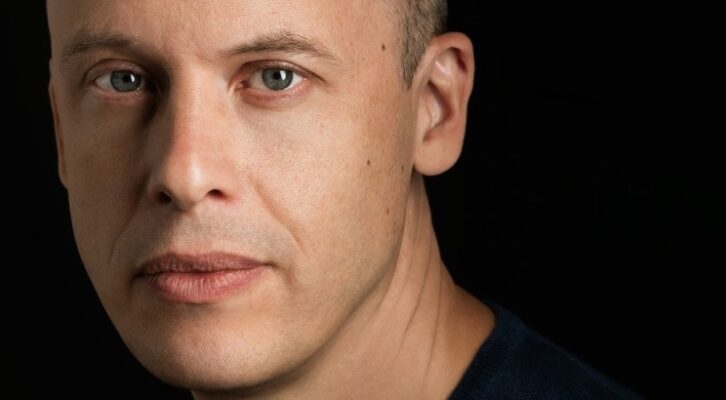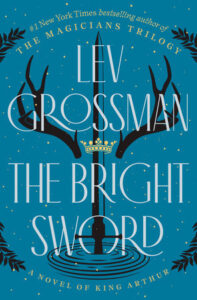
Lev Grossman on Adapting Arthurian Legends For a World in Turmoil
Jane Ciabattari Talks to the Author of “The Bright Sword”
I reviewed Lev Grossman’s The Magicians when it was launched in 2009, with amazing timing: Harry Potter and the Deathly Hallows, the final book, was out in paperback, and Harry Potter and the Half-Blood Prince was at last onscreen. Fans were bemoaning the coming Harry Potter vacuum. Grossman, at that point a Time magazine senior book critic, former National Book Critics Circle board member, and Nerd World blogger, transports us from Brooklyn to Fillory, a magical X-rated universe filled with spell-casters and villains, sex, drugs, and single-malt scotch. Quentin Coldwater, his “ridiculously brilliant” seventeen-year-old protagonist, ends up at Brakebill’s magic school up the Hudson instead of Princeton. And an epic best-selling trilogy began, to be followed by a Syfy TV series, which lasted for five seasons, until 2020.
With The Bright Sword, Grossman returns to the fantasy-quest novel, but this time he’s taking on the Arthurian canon with a book that took a decade to write. His irresistible reimagining of the legend, in a world where King Arthur and most of the knights of the Round Table are dead, with a young outsider arriving on the scene to be challenged by a quest beyond his imagining, is once again timely, as the “real” world reckons with an unimagined future. (And yes, there’s a TV series in the works.) Our conversation spanned the continent, as Grossman was back in Brooklyn for his book launch (he and his family live in Australia).
*
Jane Ciabattari: How has this period of pandemic and turmoil affected your life, your work, the writing and launch of The Bright Sword?
Lev Grossman: Not for the better! Work on the book mostly ground to a halt in 2020 while my kids were out of school. In some ways novel-writing is a momentum game, and I lost a lot of momentum. Also I couldn’t travel to the UK for research nearly as much as I would’ve liked. I had to do a lot of googling of birds and wildflowers.
I wanted to know what happens to the people who have to keep on living after the end of the world.
If turmoil includes the Trump presidency, that definitely left its stamp on The Bright Sword too. Like America, Arthur’s Britain is a land bitterly divided against itself.
JC: What drew you to shift from the “Harry Potter for grown-ups” universe of The Magicians trilogy, which begins in Brooklyn and reaches to the fantasy world of Fillory and beyond, to the Arthurian realm?
LG: I’d been writing Magicians books off and on for ten years, and the magicians and I needed some time apart. King Arthur is one of my first loves as a reader, and I felt like he must have something to say about this historical moment we’re in, and I wanted to know what it was.
JC: You’ve said this book took you ten years to write. What all was involved?
LG: That is a good if somewhat painful question. Obviously there was a lot of research. Arthur’s time was a very weird and complex moment in British history. The Romans had left, the Saxons were coming, and in between society basically collapsed into bits and pieces.
Also I needed to find my Arthur. He’s a challenging character—he’s almost a Harry Potter story in a way, an obscure, abused orphan who discovers he’s actually a famous hero, but his new life comes with so much baggage and history and trauma. What is it like to be Arthur? The medieval sources don’t give you much to work with. He doesn’t get a lot of monologues—Shakespeare never wrote a King Arthur play.
JC: We’ve spoken in the past about the influence of the Narnia books upon The Magicians trilogy. What is the Arthurian canon that preceded this new work—T.H. White, Marion Zimmer Bradley, Thomas Malory, Tennyson, Mary Stewart, Rosemary Sutcliff, others? What inspired you to write a novel of King Arthur? Why this title?
LG: In terms of the canon, I was thinking about all of those writers you mentioned, especially Malory and T.H. White and Bradley, but also some of the earlier Arthur stuff—Geoffrey of Monmouth, Gawain and the Green Knight, Clwch and Olwen, the Mabinogion. The funny thing is that even after all that, there turn out to be so many stories that still haven’t been told.
In terms of the title…I try never to overthink my titles. Like with The Magicians, the label’s right there on the tin.
JC: As you write in a historical note, “Arthur didn’t spring to life fully formed, he was deposited in layers, slowly, over centuries…” The world of The Bright Sword, you write, “is kind of a dream of medieval Britain, where disparate elements from different periods mingle and fuse in ways they never did in the real world, but which make a kind of sense on the level of our shared cultural unconscious…” What was your worldbuilding strategy, given the complexities of the Arthurian legend?
LG: I tried to be guided by two things. One was romance. We’ve had a lot of gritty, grounded, hard-boiled Arthurs lately. I wanted to go the other way and lean into the magic and the spectacle and romance of it all. Shining armor, soaring castles, courtly love, jousting, magic, angels, fairies. Aaron Sorkin took all the magic out when they revived Camelot. I wanted to put it back in.
But at the same time I didn’t want to lose a sense of relevance to what’s happening right now. Arthur’s world had to have the same kinds of conflicts ours has. Like, for example, the fact that Arthur’s Britain was a post-colonial country—it was still trying to de-colonize after centuries of Roman occupation, and deal with the legacy of that darkness and violence. And Arthur, as a Romanized Briton, is caught up in the middle of it.
JC: I’m curious about the progression of your work on The Bright Sword. How did you begin? At what point did you set the quest as beginning at the end of the Round Table, with Arthur and most of the Round Table defeated by Mordred at the Battle of Camlann? How did you delineate your own innovations in the storylines? Did you have the answer to the mystery—who will replace Arthur on the throne?—from the beginning?
LG: I started thinking about the world after Arthur’s death very early on in the process. I was looking for blank spaces on the map, and it’s pretty clear that when Arthur died with no surviving children, a massive succession crisis would come next. The idea of that golden chivalric world losing its center, descending into darkness and disorder…I wanted to read that story. I wanted what was in some ways a post-apocalyptic story. I wanted to know what happens to the people who have to keep on living after the end of the world.
And the answer to that last question is no. I only found out when I got to the end.
JC: How did the character of Collum of the Out Isles—“an orphan and a bastard, poor as a church mouse and very far from home,” the young knight we meet in your opening scene, who has dreamt of joining King Arthur’s Round Table for years and now is going to Camelot too late—evolve? Is he based on a historic character?
LG: In some ways Collum is kind of a stock character. Mysterious young men are always turning up at Camelot, seeking their fortune. Collum is also a proxy for the reader, as an outsider finding his way at court.
But as he evolved I realized that Collum was really a shadow of Arthur himself, who like Collum had grown up in obscurity, an orphan and a bastard. He’d suffered abuse. They face a lot of the same challenges—but their fates are very different.
JC: How did you select and build out the other characters, the four surviving knights of the Round Table —Bedivere, the one-handed knight who appears in some of the earliest Arthurian tales, not to mention Monty Python and the Holy Grail, who in your story is secretly in love with Arthur; Palomides, the Saracen, a Muslim knight who you depict as a prince from Baghdad; Sir Dagonet, the court jester, and Sir Constantine, who is a potential successor to Arthur—and Nimue, Merlin’s apprentice, who bests him before the action begins? Your back stories—The Tale of Sir Palomides, The Tale of Sir Dagonet and Sir Constantine; or The Quest for the Holy Grail or, the Very Last Adventure, The Tale of Nimue—are engrossing. Did you write them in any particular order?
With all the heroes gone I could…bring to the center some people who don’t usually get to be the main characters.
LG: And forget not the bold Sir Dinadan! At first when I looked into who actually survived after Arthur’s death at Camlann, I panicked, because almost nobody was left. But then I realized what an opportunity it was, because with all the heroes gone I could look in the margins, and bring to the center some people who don’t usually get to be the main characters.
Some of them were just old favorites of mine, like Sir Dagonet, the Fool Knight—I always wondered what it was like to be a court jester raised to the Round Table. But I probably wrote Sir Palomides’ story first. He’s always been a mystery to everybody—no one ever talks about what a Muslim knight is doing in Britain, chasing a beast whom he is fated never to catch. I had Palomides come from Golden Age Baghdad, which means he’s from a civilization far more advanced than Arthur’s. The Round Table all look like barbarians to Palomides.
JC: What sort of research went into the battle scenes (your details on armor, weaponry, style are fascinating)? And the creatures?
LG: There are so many rabbit holes to go down. Even just the way knights really fought, the actual martial art they practiced, was only rediscovered in the past few decades by scholars and enthusiasts who studied the original swordfighting manuals and worked out the moves. There’s a lot to study. I took a couple of longsword classes myself. Though I didn’t show a lot of knightly potential.
As for the big battle scenes…I read a lot of military history, especially first-person accounts, to try to absorb how terrifying and confusing it must have been. And I read the great literary battle scenes, like the deconstructed Napoleonic battles in War and Peace, and Karl Marlantes’ Vietnam novel Matterhorn. And of course the modern masters of the fantasy battle, like George R.R. Martin and Joe Abercrombie.
As for the creatures, I don’t think any research can prepare you for the Questing Beast, who is just about the single weirdest thing in the Arthurian universe. I hope I did her justice.
JC: What are you working on now/next? Is The Bright Sword the beginning of another trilogy?
LG: Right now I’m having an incredible time co-writing a graphic novel with Lilah Sturges called The Heavens. It’s a space opera! As for The Bright Sword, as far as I know it’s a standalone novel. But then again I said that about The Magicians too.
__________________________________

The Bright Sword: A Novel of King Arthur by Lev Grossman is available from Viking Books, an imprint of Penguin Publishing Group, a division of Penguin Random House, LLC.
Jane Ciabattari
Jane Ciabattari, author of the short story collection Stealing the Fire, is a former National Book Critics Circle president (and current NBCC vice president/events), and a member of the Writers Grotto. Her reviews, interviews and cultural criticism have appeared in NPR, BBC Culture, the New York Times Book Review, the Guardian, Bookforum, Paris Review, the Washington Post, Boston Globe, and the Los Angeles Times, among other publications.



















